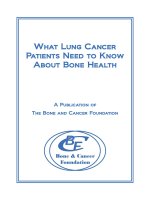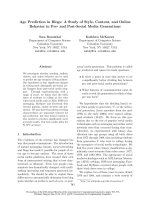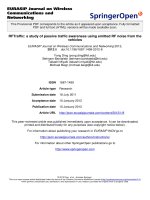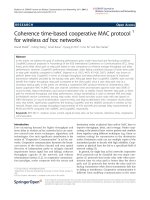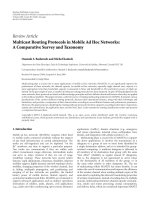On applying network coding to wireless ad hoc networks a study of robustness, efficiency and cross layer synergy
Bạn đang xem bản rút gọn của tài liệu. Xem và tải ngay bản đầy đủ của tài liệu tại đây (999.33 KB, 188 trang )
ON APPLYING NETWORK CODING TO
WIRELESS AD HOC NETWORKS: A STUDY OF
ROBUSTNESS, EFFICIENCY AND
CROSS-LAYER SYNERGY
WANG JIN
(B.Eng., Harbin Institute of Technology, China)
Supervised by
Professor WONG Wai-Choong, Lawrence
Dr. CHAI Teck Yoong
A THESIS SUBMITTED FOR THE DEGREE OF DOCTOR
OF PHILOSOPHY
DEPARTMENT OF ELECTRICAL & COMPUTE R
ENGINE ERING
NATI ONAL UNIVERSITY OF SINGA PORE
2015
DECLARATION
I hereby declare that the th esis is my original work and it has been written
by me in its entirety.
I have duly acknowledged all the sources of information which have been used
in the thesis.
This thesis has also not been submitted for any degree in any university
previously.
WANG Jin
February 18, 2015
i
Acknowledgments
Having completed my PhD thesis, I would like to take this opportunity to thank
the following people: Professor Wai-Choong Wong, Lawrence and Dr. Teck
Yoong Chai, for their continuous guidance and support during my course of the
PhD study. In the past five years, they had trained me not only on how to con-
duct research, but much more than that, including technical writing, communi-
cation, and social interaction skills. I will carry over the spirit of self-motivation
and independence, which they taught me during my study. Without their help,
I would not be able to finish my PhD study and this thesis would have been
getting nowhere.
Pursuing a PhD degree is n ot merely an academic pursue. There are also
many administrative matters that need to be handled. Without the assistance
from Miss Jie Guo, it is impossible for me to handle all the paper works on time.
As such, I wish to express my gratitude to her!
The China Scholarship Council offered me a scholarship and the School of
Engineering, National University of Singapore waived the tuition fee for me and
offered me a good place to stud y. This opportunity changed my life so mu ch
that I will alway s be thankful during the r est of my life.
Last but not the least; I would like to thank my parents, for their support
and encouragement throughout my years of studies. They have guided me both
in study and in life, I hope what I have done and what I will be doing make
them proud of me. At the same time, my fianc´e Mr. Cenzhe Zhu is one of the
ii
most important persons, if not the most important one, in helping me complete
my PhD study. Although he is not specialised in the area of my research, his
perspectives always inspires me. In addition, the happiness and wisdom he
brought into my life were very important in overcoming the difficulties I faced.
The accomplishment of the dissertation undoubtedly reflects his contributions.
February 18, 2015
iii
iv
Table of Contents
Summary x
List of Tables xi
List of Figures xi
List of Symbols xv
List of Abbreviations xviii
1 Introduction 1
1.1 Background . . . . . . . . . . . . . . . . . . . . . . . . . . . . . . 1
1.2 Research Challenges . . . . . . . . . . . . . . . . . . . . . . . . . 4
1.3 Thesis Contribution . . . . . . . . . . . . . . . . . . . . . . . . . 8
1.4 Thesis Organization . . . . . . . . . . . . . . . . . . . . . . . . . 11
2 Related Works 13
2.1 Overview of Network C oding . . . . . . . . . . . . . . . . . . . . 13
2.1.1 Robustness in wireless ad hoc networks . . . . . . . . . . 18
2.2 Network Coding for Scheduling Problem . . . . . . . . . . . . . . 19
v
2.2.1 Overheads in Network Coding . . . . . . . . . . . . . . . . 19
2.2.2 MAC-Layer and Physical-Layer Scheduling . . . . . . . . 22
2.3 Content Distribu tion in Wireless Ad Hoc Networks with Network
Coding
. . . . . . . . . . . . . . . . . . . . . . . . . . . . . . . . . 24
2.3.1 Overview of Cross-layer Designs . . . . . . . . . . . . . . 24
2.3.2 Content distribution using BitTorrent-like protocols . . . 27
3 Improving the Robustness of Coding-aware Routing Protocols
to Flow Arrivals 29
3.1 Introduction . . . . . . . . . . . . . . . . . . . . . . . . . . . . . . 29
3.2 Protocol Overview . . . . . . . . . . . . . . . . . . . . . . . . . . 35
3.2.1 Digest of the DCAR protocol . . . . . . . . . . . . . . . . 35
3.2.2 Two tables to store flow information . . . . . . . . . . . . 40
3.2.3 Self recommendations . . . . . . . . . . . . . . . . . . . . 41
3.2.4 Handling Self Recommendations . . . . . . . . . . . . . . 42
3.2.5 Decision Making . . . . . . . . . . . . . . . . . . . . . . . 42
3.2.6 Controlling the Frequency of Self Recommendations . . . 43
3.3 Route-Change Procedure . . . . . . . . . . . . . . . . . . . . . . 44
3.3.1 Procedure Timeline . . . . . . . . . . . . . . . . . . . . . 44
3.3.2 The Unbiased CRM Metric . . . . . . . . . . . . . . . . . 46
3.4 Topology Analysis . . . . . . . . . . . . . . . . . . . . . . . . . . 48
3.4.1 Theoretical In duction of Indicators . . . . . . . . . . . . . 49
3.4.2 Simulation Results . . . . . . . . . . . . . . . . . . . . . . 58
3.5 Evaluation . . . . . . . . . . . . . . . . . . . . . . . . . . . . . . . 62
vi
3.5.1 Simulation 1. Simple Topology . . . . . . . . . . . . . . . 64
3.5.2 Simulation 2. “Wheel” Topology . . . . . . . . . . . . . . 66
3.5.3 Simulation 3. Grid Topology . . . . . . . . . . . . . . . . 69
3.6 Chapter Summary . . . . . . . . . . . . . . . . . . . . . . . . . . 72
4 Improving Coding Efficiency and Fairness by Network-layer Packet
Scheduling Algorithm
75
4.1 Introduction . . . . . . . . . . . . . . . . . . . . . . . . . . . . . . 75
4.2 The Static Form of the Problem . . . . . . . . . . . . . . . . . . 79
4.2.1 Weighted Clique Cover Prob lem . . . . . . . . . . . . . . 79
4.2.2 Solution to WCCP . . . . . . . . . . . . . . . . . . . . . . 84
4.2.3 Scalability and Error Analysis . . . . . . . . . . . . . . . . 92
4.3 The Dynamic Form of the Problem . . . . . . . . . . . . . . . . . 98
4.3.1 Heuristic Scheduling . . . . . . . . . . . . . . . . . . . . . 100
4.3.2 Performance with Poisson Arrivals . . . . . . . . . . . . . 105
4.4 Evaluation . . . . . . . . . . . . . . . . . . . . . . . . . . . . . . . 109
4.4.1 Simulation 1 . . . . . . . . . . . . . . . . . . . . . . . . . 112
4.4.2 Simulation 2 . . . . . . . . . . . . . . . . . . . . . . . . . 116
4.5 Chapter Summary . . . . . . . . . . . . . . . . . . . . . . . . . . 118
5 Cont e nt Distribution in Wireless Ad Hoc Networks with Net-
work Coding
119
5.1 Introduction . . . . . . . . . . . . . . . . . . . . . . . . . . . . . . 119
5.2 Routing Metric . . . . . . . . . . . . . . . . . . . . . . . . . . . . 122
vii
5.3 Application-layer Strategies . . . . . . . . . . . . . . . . . . . . . 126
5.4 Implementation . . . . . . . . . . . . . . . . . . . . . . . . . . . . 130
5.4.1 Initial Setup . . . . . . . . . . . . . . . . . . . . . . . . . 130
5.4.2 Cross-layer Dynamics . . . . . . . . . . . . . . . . . . . . 133
5.4.3 Simulation Settings . . . . . . . . . . . . . . . . . . . . . . 134
5.4.4 Results . . . . . . . . . . . . . . . . . . . . . . . . . . . . 135
5.5 Chapter Summary . . . . . . . . . . . . . . . . . . . . . . . . . . 139
6 Conclusion 141
6.1 Thesis Contribution . . . . . . . . . . . . . . . . . . . . . . . . . 141
6.2 Fu ture Work . . . . . . . . . . . . . . . . . . . . . . . . . . . . . 145
Bibliography 147
List of Publications 163
viii
Summary
Due to its fast deployment, error tolerance, and sophisticated protocol stack , the
technique of wireless ad hoc networks is utilized in more and more applications.
Network coding, typically as a method to improve throughput, is quite suitable
for wireless networks. The broadcast nature of wireless networks is analogous to
multi-casting for which network coding was originally devised.
In this thesis, we analyse several issues on applying network coding tech-
niques to wireless ad hoc networks. Several aspects, including the robustness,
fairness, the coding efficiency and the possible synergy between network layer
and application layer are stu died.
Specifically, we first propose a coding-aware routing protocol that is able
to detect coding opportun ities even if the order of arrival of packet flows is
unfavourable to such detection. This robustness is essential because wireless ad
hoc networks are prone to node failures, node joining, and topology changes.
These can significantly impact performance if the routing protocol is not robust
enough.
Then we dig deeper into the inner structure of the coding scheme and prove
that coding-aware packet scheduling is pivotal in shaping the distribution of
throughput among flows. Compared to a trivial round-robin scheduling, our
scheduling method decreases the span and variance of per-flow throughputs. In
addition, a well planned scheduling can improve the coding efficiency. A good
scheduling algorithm is not on e that only schedules packets with higher coding
ix
benefits. Instead, it should plan ah ead and avoid cases when some packets that
could have been coded are left behind with no coding counterpart. Thus, a
practical coding-aware packet scheduling algorithm is devised, with the goal to
improve fairness and coding efficiency.
Finally, the above-mentioned improvement in the network layer is incorpo-
rated into a Peer-to-Peer (P2P) content distribution protocol, capitalizing on
the synergy between network layer and application layer . The availability of
cross-layer information can greatly help both in network layer and in application
layer. By taking the offered load information from the ap plication layer as a
substitute for the queue length, the routing protocol can now measure the traffic
load of a flow more accurately. On the other hand, the routing metric ob tained
from the network layer can help the application layer to determine which neigh-
bour peers to connect to. The peer with a better route would be favoured, thus
enlarging the coding benefits. In addition, the network layer can back-propagate
rate adjustment packets to actively adju st offered load according to the coding
graph and the solution to the
Weighted Clique Cover Problem (WCCP), where
the information is only available in network layer but not in application layer.
Results show that such cross-layer solution can greatly im prove performance.
x
List of Ta bles
3.1 Definition of a Few Terminologies . . . . . . . . . . . . . . . . . . 49
4.1 Default Parameters for Performance Evaluation of the Static-
Form Problem
. . . . . . . . . . . . . . . . . . . . . . . . . . . . 95
4.2 Simulation 1 Parameter Settings . . . . . . . . . . . . . . . . . . 113
5.1 Simulation Parameters . . . . . . . . . . . . . . . . . . . . . . . . 135
xi
List of Figures
1.1 A Typical Wireless Ad Hoc Network . . . . . . . . . . . . . . . . 2
3.1 A Sim ple Test Scenario for SCAR . . . . . . . . . . . . . . . . . . 32
3.2 Route-Change Procedure Timeline (SR: Self Recommendation.
MRQ : Modified RREQ Packet. MRP: Mod ified RREP Packet.)
. 45
3.3 Modified RREQ/RREP Packet Formats . . . . . . . . . . . . . . 47
3.4 Possible Topologies for 2 Coding-possible Route Pairs . . . . . . 53
3.5 Possible Topologies for 3 Coding-possible Route Triples . . . . . 55
3.6 An Artificially Designed Topology to Measur e the Effectiveness of
CN Indicators
. . . . . . . . . . . . . . . . . . . . . . . . . . . . 59
3.7 Scatter P lot of Throughput Gain with Different C2 Values . . . . 59
3.8 Average Throughput Gain versus Pre-adjusted C2 Values . . . . 60
3.9 Average Throughput Gain versus Adjusted C2 Values . . . . . . 60
3.10 Scatter Plot of Throughput Gain with Different C3 Values . . . . 62
3.11 Aver age Throughput Gain versus Pre-adjusted C3 Values . . . . 63
3.12 Aver age Throughput Gain versus Adjusted C3 Values . . . . . . 63
3.13 Simulation Results for the Simple Test Top ology . . . . . . . . . 65
xii
3.14 Simulation Results for “Wheel” Topology . . . . . . . . . . . . . 67
3.15 Simulation Results for Grid Topology . . . . . . . . . . . . . . . 71
4.1 There Exists Polynomial Solutions to WCCP for Claw-free Perfect
Graphs
. . . . . . . . . . . . . . . . . . . . . . . . . . . . . . . . . 83
4.2 One Example of Coding Graph . . . . . . . . . . . . . . . . . . . 86
4.3 The Overall Block Diagram of the Algorithm for WCCP . . . . . 88
4.4 Processing Time Sensitivity to N . . . . . . . . . . . . . . . . . . 96
4.5 Processing Time Sensitivity to p . . . . . . . . . . . . . . . . . . 96
4.6 Processing Time Sensitivity to mean(w) . . . . . . . . . . . . . . 96
4.7 The Error Rate and Average Error with Different Q Values . . . 98
4.8 Average Throughput Per formance with Poisson Arrivals . . . . . 107
4.9 Minimum Throughput Performance with Poisson Arrivals . . . . 108
4.10 A Topology where Source and Destination Nodes are on the Same
Circle . . . . . . . . . . . . . . . . . . . . . . . . . . . . . . . . . 113
4.11 The Generated Topology for Simulation 1 . . . . . . . . . . . . . 113
4.12 Coding Graph at Node O in Simulation 1 . . . . . . . . . . . . . 114
4.13 Per-flow Throughput in Simulation 1 . . . . . . . . . . . . . . . . 115
4.14 Random Topology . . . . . . . . . . . . . . . . . . . . . . . . . . 117
4.15 Per-flow Throughput of Simulation 2 . . . . . . . . . . . . . . . . 117
5.1 The flow chart dep icting the generation of INC/DEC packets . . 130
5.2 Special RRE Q/RREP Packet Formats . . . . . . . . . . . . . . . 132
5.3 Cumulative Percentage Finished over Time . . . . . . . . . . . . 136
xiii
5.4 Number of Coded Packets Sent . . . . . . . . . . . . . . . . . . . 137
5.5 Upload/Download Amounts for Selected Pairs . . . . . . . . . . . 139
xiv
List of Symbols
C2
adj
The adju sted C2 indicator.
C2, C3, . . . , CN The CN series of topology indicators.
E An edge set.
⌊·⌋ The floor of a floating-point number, i.e., the maximum integer that is smaller
than the given number.
f
n
A new coming flow in a network.
f
p
A potential flow in a network.
G A graph.
k
2
The number of combinations choosing 2 from k items.
K
m,n
A bipartite where m and n are the cardinalities of its two disjoint vertex
set.
G(n, p) A random graph generator that generates a graph with n vertices and
a probability parameter p.
xv
MQ
d
The dynamic version of MQ (Modified Queue Length).
MQ
s
The static version of MQ (Modified Queue Length).
N(v) Th e set of neighbouring vertices of a vertex v.
Φ The empty set.
P
l
The packet loss rate of lin k l.
Q The quantization level of the approximation algorithm.
r
in−use
Previously-in-use route.
r
i
∼ r
j
A flow that takes route r
i
can be coded with another flow that takes
route r
j
.
R(S − D ) The set of possible routes from node S to node D.
r
sr
The recommended route from source to destination.
Σ
∗
, Γ The optimal allocation method.
U(i, j) The amount of packets uploaded by node i to node j.
V A vertex set.
|V| The cardinality, or the number of vertices, of a vertex set.
V
q
i
, Q
i
The i-th clique of graph G, represented by its vertex set. In some context,
it is simply den oted by Q
i
.
xvi
w(·) A function that maps a vertex to an integer weight.
w
q
i
The uniform weight of the i-th clique of graph G.
Z
+
The set of positive integers.
xvii
List of Abbrev iations
ACK Acknowledgement packet.
AODV Ad-Hoc On-demand Distance Vector.
ARQ Automatic Repeat-reQuest.
BT BitTorrent.
CCP Clique Cover Problem.
CRM Coding-aware Routing Metric.
DCAR Distributed Coding-aware Routing.
DMDP Deterministic Markov Decision P rocess.
DPSA Dynamic Packet Scheduling Algorithm.
DSR Dynamic Source Routing.
ECT Expected Coded Transmission Time.
EDGE Enhanced Data rates for GSM Evolution.
xviii
ETX Expected Transmission Count.
FIFO First-In-First-Out.
GPRS General Packet Ratio Services.
GSM Global System for Mobile Communication.
HEU Heuristic Scheduling Scheme.
LTE Long Term Evolution.
MAC Media Access Control.
MDP Markov Decision Process.
MIMO Multiple-Input-Multiple-Output.
MIQ Modified Interference Queue Length.
MIT Massachusetts Institute of Technology.
MQ Modified Queue-length.
MRP Modified RREP Packet.
MRQ Modified RRE Q Packet.
NA Non-Approximation Algorithm.
OLSR Optimal Link State Routing.
OSI Open System Interconnect.
xix
P2P Peer-to-Peer.
PHY Physical layer.
pps Packet Per Second.
QoS Quality of Service.
RC Route-Change.
RNC Random Network Coding.
RR Round-Robin.
RREP Route REsPonse Packet.
RREQ Route REQuest Packet.
SCAR Self recommendation Cod ing-Aware Routing Protocol.
SR Self Recommendation.
TCP Transmission Control Protocol.
TCP/IP Transmission Control Protocol / Internet Protocol suite.
UMTS Universal Mobile Telecommunications System.
VANET Vehicular Ad Hoc Network.
WCCP Weighted Clique Cover Problem.
WCG Weighted Cod ing Graph.
xx
Wi-Fi Wireless Fidelity.
XLiNC Cross-layer Solution with Network Coding.
xxi
xxii
Chapter 1
Introduction
1.1 Background
Recent years have seen the proliferation of wireless solutions for communica-
tion purposes. Industry-level mobile networks have advanced from analogue
signals to digital signals, from th e 2G
Global System for Mobile Communication
(GSM)
technology, through 2.5G General Packet Ratio Services (GPRS)/En-
hanced Data rates for GSM Evolution (EDGE)
, 3G Universal Mobile Telecom-
munications System (UMTS)
to the now rising 4G Long Term Evolution (LTE)
networks. In fact, a survey in 2013 [1] has already pointed out that th e pace
of growth of wireless subscriptions has slowed to the extent of reaching satura-
tion. New growth areas include multi-device plans and greater customization of
service plans. Concurrently, home
Wireless Fidelity (Wi-Fi) coverage is gr owing
steadily, tapping the power of 802.11 series of protocols. Its bandwidth, reliabil-
ity, and manageability have persuaded more and more u sers to shift from wired
1

